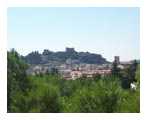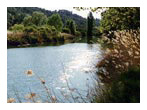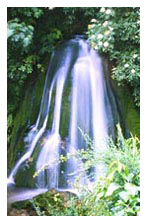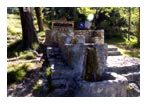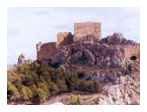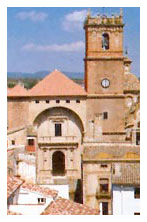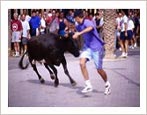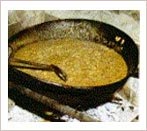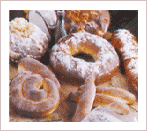Ayora offers an infinite variety of possibilities to discover beautiful places, natural spaces (La Hunde, Palomera, Caroig), mountains, plains or humid lands and even places in those that the step of old civilizations has left its artistic and cultural print (The Layer of Meca). Its architectural patrimony is very wide, it possesses a medieval Castle (XIII century), Parochial Church (XVI century) and numerous Hermitages located inside and outside of the population. Their Popular Parties are known in the whole Valencian Community by their tradition tourney and great festivity. Ayora is without a doubt a town of great popular tradition (The Miracle of the Angel of Ayora), and its gastronomy is as its people, of the earth and of the flavour of the charms that the wealth that surrounds this population take place.

The Valley of Ayora runs between mountain ranges of the Big hole, Palomera and Mugrón, al the west, and the Tooth of Cuts of Pallás and the bulk of Caroig, al this. Its landscape, route by numerous forest tracks that cross their valleys and border their teeth, it locks up many attractiveness: the cave paintings in the shelters of Tortosillas, of the deaf person, Montes and in the cave of Don Juan, next to Moragete, with spectacular formation of stalagmites and stalactites; hill of Agras, main volcanic outcrop of the community, in Cofrentes, population where the rivers Cabriel and Júcar become united; the viewpoint of Jalance, when coming out of the population in direction the west; the river basin of the Cantabán river, place of the Rochas and the sources of the Tabarro, the Beautiful one and of the Ral, in Jarafuel; the Tooth of Cuts in Cuts of Pallás; Gorges, interesting geological phenomenon between the precipices of Coal bunkers and of the Argongueña, in Teresa de Cofrentes; the Zarra river and viewpoint of the Sickle, in Zarra; and Castellar of Mecca, one of the Iberian cities more spectacular of the peninsula, and considered the second European city with more than 50.000 people, the natural place of Sinks and the source of the Chain, in Ayora. Among other itineraries, it is recommended to make a circular route by the forest, with an average duration approximated of three hours: House of Sinks It, Palomera (1.260 ms), Black Cave and Sink It.
This Valencia region offers, therefore, to the visitor’s extraordinary places and natural views. Nailed between mounts populated with trees, forest low and abundant vegetation, provides a rich variety to us as much in fauna as in flora, becoming thus a typical landscape of Mediterranean inner zones. Limit to the province of Albacete we admired before our eyes the alternation of full colour extension of fields and earth of culture. Vegetation: they dominate the formation of cork oaks, different kind of pine trees, rockroses and heather. In addition we can be found with melojo, disk, maple, rivet Valencian and the holly. Fauna: they emphasize the gallipato, stairs snake and the bastard, the perdicera eagle, the culebrera eagle, worn eagle, the azor, the real owl, the small owl, the wild boar, marten, badger, the partridge, the rabbit, the hare, the wild and the goat.
The importance of conservation of these natural resources, the recovery of traditional agricultural activities and the restoration of old houses and farming houses have revitalized these zones, when creating a tourist supply different and attractive, that it opens very diverse possibilities of leisure and relaxation; to know the cultures, native fauna and flora in accordance with the environmental conservation policy.
One of the great opportunities that we, the Spaniards enjoyed, by the own wealth and diversity of the geography of our earth, is in the facility stops to develop activities related to the agriculture tourism. With no need of making long displacements, not even to leave the borders of our Valencia community, we are sure that all the Valencia’s, near his habitual place of residence, has and can enjoy some natural place that helps his personal development by the mere contact with the nature.
More information of The Valley of Ayora

Castle of Ayora. Dominating the Villa of Ayora, of Arab origin, with two strong squares surrounded for near a thousand wall meters, it was scenario in the Fights Slang’s, Guerra of Secession and Carlist Wars. The tower of the homage, the false door, is conserved some canvases, walls, etc. To its feet the Medieval Church of Santa Maria of Gothic style runs off with, in which is a Baroque altarpiece of 1702.
Parochial church of Our Mrs. of the Asunción. The group located in the population's centre, is more than an interesting summary of the architecture among the XVI and XVIII centuries. Their first construction phase is located between 1508 and 1577. Of Renaissance style it highlights their important vault of recently restored cross vault and the facade in style herreriano. In their interior paintings of Yáñez of the Almedina are conserved, painter formed in Venice by Leonardo Da Vinvi´s pupils and the painting of "Angel’s" Miracle", of Vicente Lopez Portaña.
Route of the Hermitages. This cultural route understands a journey for 7 of the 15 more outstanding hermitages of Ayora and located in the different neighbourhoods of the municipality, as well as in the surroundings. The route leaves of the Parochial Church of the Asunción and to continue for Saint Maria the biggest Hermitage , hermitage of Santa Lucia, hermitage of Saint José, hermitage of Santa Barbara, hermitage of the Sacred Angel (next to the ruins of the hermitage of Saint Roque), hermitage of the Rosario's Virgin, and hermitage of Saint Anton.
Other monuments. The Cruz of Saint Antón located next to the hermitage of San Anton dates from the XVI century. San Francisco's convent, current House of the Culture, built in 1573 and refurbished in 1778 preserve their cloister of two floors. Remain silent of the Marquise of Zenete, there are data of their importance from 1550. Cavanilles describes it as "superior to how many there is in the Kingdom, without accepting those of the capital". There are several houses noblemen with interesting facades. The Rasher, built in 1892, on the lot of the old city council. Their metallic structure is of style modernist.

The biggest parties take place from the 9 to August 16 in honour to the Virgin of the Asunción. Of the parties the tourney acts that they go from the entrance of heads to the test of heifers and the bullfighting of the same ones highlight. May 3, day of the Cruz, takes place the pilgrimage to the biggest Mount. November 30, festivity of Saint Andrés, is the day of the pattern of Ayora, to which is celebrated with blazes and other acts in the street that takes his name.
On second Monday of January, the Sacred Angel’s Party that he liberated from the pest to the population in 1392 takes place. The carnivals in February with great civic participation and the great event of the last years "the Fair of the Honey", of the 10 at October 12.

The gastronomy of Ayora is as its people, of the earth and of the flavour of the charms that the wealth that surrounds this population takes place. The most characteristic plate is without place to doubts it is the "gazpacho ayorino" that incorporates chicken meat, rabbit, partridge or pigeon, and once elaborated they are served on the traditional cake of wheat. It is habit in Ayora, to make popular "chazpachás", where the whole people of the town prepare in the square her pan of gazpachos, and they share it with her relatives and friends.
The "agetao" is a typical plate with the help of white beans cooked with cod and "ajoaceite" (Garlic-oil) that is carried out in the Angel’s festivity. The "gachamiga" can be flavoured mainly in winter, in the "slaughter of the pig"; the elaborated sausage in a handmade way is of great quality and it maintains the traditional flavour of in the past.
The kitchen of Ayora also offers a numberless of pastas and sweet, as the "mead" or the "almendraos", magdalenas, mantecados, flukes elaborated by the ovens and bakeries maintaining with its occupation the knowledge and the good customs of the traditional food. It is necessary to highlight as product it shatters the honey, of handmade production and of international recognition for their quality and properties.
More information about our Mediterranean cuisine
Rurals House » Holidays in Valencia
 Landhaus
Landhaus Landhuis
Landhuis Rural house
Rural house Casas Rurales
Casas Rurales Maison
Maison Casale
Casale Allotjament
Allotjament Russian
Russian Alojamento
Alojamento Chino
Chino